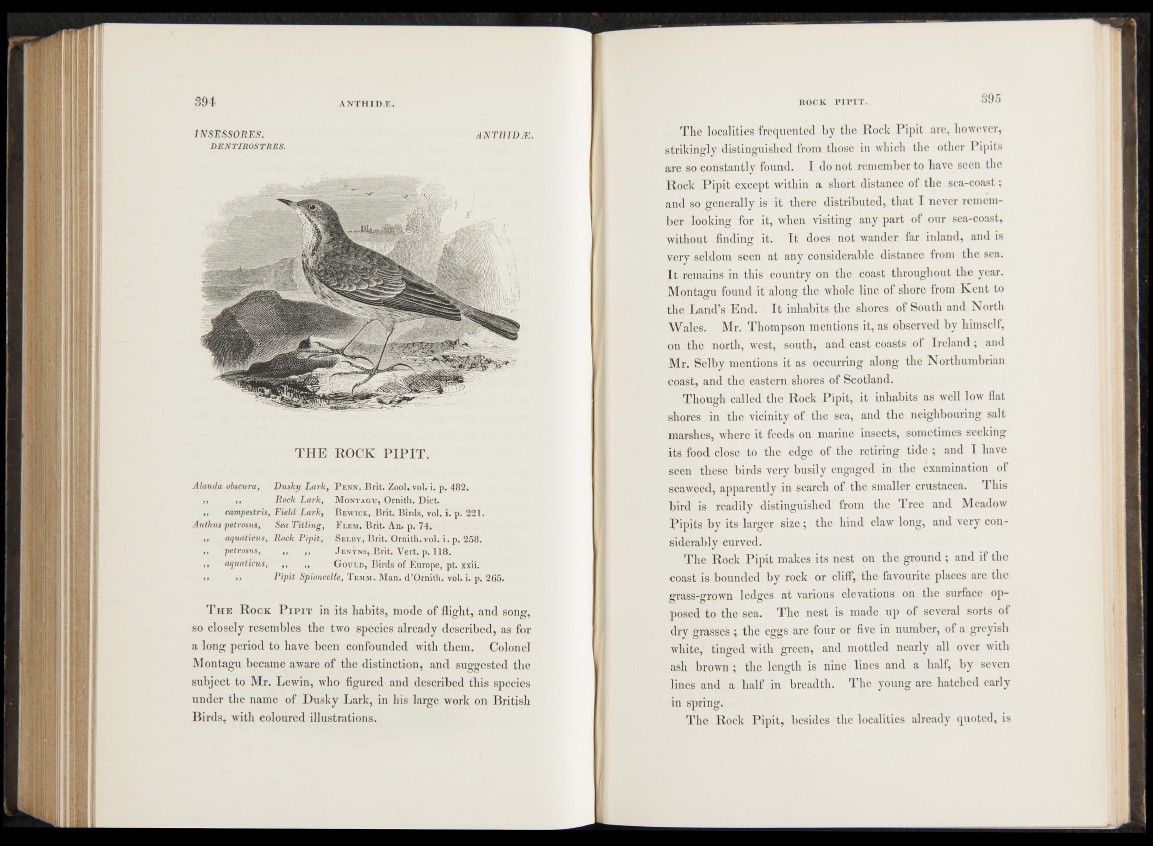
ÏNSESSORES.
DENTIROSTRES.
ANTHIDÆ.
TH E ROCK P IP IT .
Alauda obscura, Dusky Lark, P enn. Brit. Zool. vol. i. p. 482.
,, ,, Rock Lark, M ontagu, Ornith. Diet.
„ campestris, Field Lark, B ewick, Brit. Birds, vol. i. p. 221.
Anthus petrosus, Sea Titling, F lem. Brit. An. p. 74.
„ aquaticus, Rock Pipit, Selby, Brit. Ornith. vol. i. p. 258.
,, petrosus, ,, „ J en yns, Brit. Vert. p. 118.
,, aquaticus, ,, „ G ould, B ird s of E u ro p e , p t. xxii.
>, >, Pipit Spioncelle, T emm. Man. d’Ornith. vol. i. p. 265.
T h e R ock P i p i t in its habits, mode of flight, and song,
so closely resembles the two species already described, as for
a long period to have been confounded with them. Colonel
Montagu became aware of the distinction, and suggested the
subject to Mr. Lewin, who figured and described this species
under the name of Dusky Lark, in his large work on British
Birds, with coloured illustrations.
The localities frequented by the Rock Pipit are, however,
strikingly distinguished from those in which the other Pipits
are so constantly found. I do not remember to have seen the
Rock Pipit except within a short distance of the sea-coast;
and so generally is it there distributed, that I never remember
looking for it, when visiting any part of our sea-coast,
without finding it. It does not wander far inland, and is
very seldom seen at any considerable distance from the sea.
It remains in this country on the coast throughout the year.
Montagu found it along the whole line of shore from Kent to
the Land’s End. It inhabits the shores of South and North
Wales. Mr. Thompson mentions it, as observed by himself,
on the north, west, south, and east coasts of Ireland; and
Mr. Selby mentions it as occurring along the Northumbrian
coast, and the eastern shores of Scotland.
Though called the Rock Pipit, it inhabits as well low flat
shores in the vicinity of the sea, and the neighbouring salt
marshes, where it feeds on marine insects, sometimes seeking
its food close to the edge of the retiring tide ; and I have
seen these birds very busily engaged in the examination of
seaweed, apparently in search of the smaller Crustacea. This
bird is readily distinguished from the Tree and Meadow
Pipits by its larger size; the hind claw long, and very considerably
curved.
The Rock Pipit makes its nest on the ground ; and if the
coast is bounded by rock or cliff1, the favourite places are the
grass-grown ledges at various elevations on the surface op-
posed to the sea. The nest is made up of several sorts of
dry grasses ; the eggs are four or five in number, of a greyish
white, tinged with green, and mottled nearly all over with
ash brown ; the length is nine lines and a half, by seven
lines and a half in breadth. The young are hatched early
in spring.
The Rock Pipit, besides the localities already quoted, is